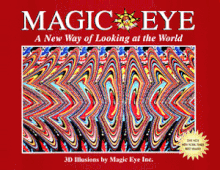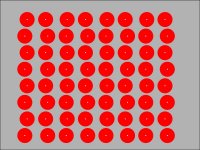I used to watch James Burke regularly - the go to presenter of the day of all things scientific and technological.Have you heard of a guy named James Burke?
Famous for his appearances on 'Tomorrow's World' and for his 'Connections' series.
James Burke Connections, Ep. 1 "The Trigger Effect" - YouTube
You need a magic eye!You have to go a bit cross-eyed.

I've still got a couple of those stereogram books from when they first came out.
Try the attached stereogram:
Attachments
The Celts, not only knew the axle, they invented the roller bearings. No kidding.I think I told you before that the wheel was the easy part!
For example, the ancients are thought to have used round logs across which they rolled heavy blocks of stone during the construction of their monuments.
To make full practical use of the wheel, we had to wait for some bright spark to invent the axle! 😎
How Ball Bearings Changed The World
Last edited:
The Day The Universe Changed was the best series. The sewing machine episode comes to mind.I used to watch James Burke regularly - the go to presenter of the day of all things scientific and technological.
Famous for his appearances on 'Tomorrow's World' and for his 'Connections' series.
James Burke Connections, Ep. 1 "The Trigger Effect" - YouTube
Available on dailymotion.com: The day the universe changed Episode 1. The way we are: It started with the Greeks. James Burke - video Dailymotion
My favourite explanation about the beginning of the Universe: Quote by Douglas Adams: “Shh!" said Ford. "It's conical. So what you do ...”
What has the Quantum ever done for us? 😀
The first chinks in Mr. Newton's classical theory came with consideration of Black-body radiation - Wikipedia.
IIRC, Mr. Planck came up with the idea of Oscillators that were Quantised. And it worked to avoid the infinities known as the Ultra-Violet Catastrophe.
Then Mr. Einstein was pondering a thing known as the Photo-Electric Effect. It only worked if the light was above a certain energy. Each metal has a thing called the work function. It clings on to Electrons with zeal. But above a certain Photon eV voltage, around 2 Volts, they give up and start emitting Electrons.
Led on to the Nobel Prize for both, AFAIK. But interestingly Einstein didn't ever win a Prize for Relativity Special or General.
Also led to essentially Quantum devices we know and love in Audio, because all you do is overcome the work function with cathode-grid bias in valves, or emitter-base bias in transistors and you have an amplifier:
Vacuum tube - Wikipedia
Semiconductor device - Wikipedia
I spent a happy 17-y-o summer playing with the Bohr Hydrogen Atom. Actually what we call semi-classical. It's not quite how it works:
Bohr model - Wikipedia
But interesting, and gave most of the right results. 😎
The first chinks in Mr. Newton's classical theory came with consideration of Black-body radiation - Wikipedia.
IIRC, Mr. Planck came up with the idea of Oscillators that were Quantised. And it worked to avoid the infinities known as the Ultra-Violet Catastrophe.
Then Mr. Einstein was pondering a thing known as the Photo-Electric Effect. It only worked if the light was above a certain energy. Each metal has a thing called the work function. It clings on to Electrons with zeal. But above a certain Photon eV voltage, around 2 Volts, they give up and start emitting Electrons.
Led on to the Nobel Prize for both, AFAIK. But interestingly Einstein didn't ever win a Prize for Relativity Special or General.
Also led to essentially Quantum devices we know and love in Audio, because all you do is overcome the work function with cathode-grid bias in valves, or emitter-base bias in transistors and you have an amplifier:
Vacuum tube - Wikipedia
Semiconductor device - Wikipedia
I spent a happy 17-y-o summer playing with the Bohr Hydrogen Atom. Actually what we call semi-classical. It's not quite how it works:
Bohr model - Wikipedia
But interesting, and gave most of the right results. 😎
Bohr`s jumping-electron-point-in-orbit planetary atomic model has been revised if I'm not mistaken...
It has but it’s still the basic model from which the later models came. Bohr + a dose of probability = new model IIUC. So the electrons occupy certain layers around the nucleus in a sort of ‘probability cloud’.
Its interesting that a photon can travel across the universe and not interact with any of the free atoms in between, or go past interposing bodies like starts etc. So I guess if a wave (photon) passes through or over an atom, or another photon, it does not necessarily always interact with it - the particles have to be positioned right.
Its interesting that a photon can travel across the universe and not interact with any of the free atoms in between, or go past interposing bodies like starts etc. So I guess if a wave (photon) passes through or over an atom, or another photon, it does not necessarily always interact with it - the particles have to be positioned right.
Or else it would not trigger anything since action/reaction happens in all ways possible at the same time, but only triggers a specific response pending on surrounding circumstances...? Spin, materials, temperature, magnetic fields, radiation ++++++
It's a wonder we can even produce gas! 😀
It's a wonder we can even produce gas! 😀
....Its interesting that a photon can travel across the universe and not interact with any of the free atoms in between, or go past interposing bodies like starts etc. So I guess if a wave (photon) passes through or over an atom, or another photon, it does not necessarily always interact with it - the particles have to be positioned right.
A good question. Seems high energy photons like X-Rays inelastically scatter off electrons, exchanging Energy and momentum.
Compton scattering - Wikipedia
But low energy ones elastically scatter. Just changing momentum direction. But don't lose energy.
Thomson scattering - Wikipedia
Probably a low cross-section of interaction too.
Good points. The latest 'oldest' Galaxy is 32 BLY (yes thirty two billion LY) away and was formed within a few million years of the BB, and yet we can see it. Its very red shifted but in reality would have been blue as it was filled with hot young stars in the early universe. Point is we can see photons from that far away.
Question: If is was say Thompson scattering, surely we would not see the Galaxy since the light would be scattered i.e. too diffuse to see? Unless what we are seeing are higher energy wavelengths (now redshifted)?
Question: If is was say Thompson scattering, surely we would not see the Galaxy since the light would be scattered i.e. too diffuse to see? Unless what we are seeing are higher energy wavelengths (now redshifted)?
The experimental fact is that light isn't scattered much by intergalactic space.
There aren't many particles in Space. Is it 100 per cubic metre? Can't remember.
I think what might explain it is a dipole antenna like an FM aerial has to be of the order of half a wavelength of the radiation to be near 100% efficient. And must have about 10^ 23 electrons.
This is not the case with light which is 4x 10^ -6 metres wavelength. And an electron which has a classical diameter of 10^ -14 metres.
Chances of them hitting dead-centre is tiny. Must be about 1 in 10^ -16 on area. Feynman would draw one of his diagrams here. The electron will be effectively stationary and frozen in time in the photon's reference frame.
Thomson scattering also seems to be done with a denser plasma. Different animal to empty space.
There aren't many particles in Space. Is it 100 per cubic metre? Can't remember.
I think what might explain it is a dipole antenna like an FM aerial has to be of the order of half a wavelength of the radiation to be near 100% efficient. And must have about 10^ 23 electrons.
This is not the case with light which is 4x 10^ -6 metres wavelength. And an electron which has a classical diameter of 10^ -14 metres.
Chances of them hitting dead-centre is tiny. Must be about 1 in 10^ -16 on area. Feynman would draw one of his diagrams here. The electron will be effectively stationary and frozen in time in the photon's reference frame.
Thomson scattering also seems to be done with a denser plasma. Different animal to empty space.
Last edited:
It’s about 3 hydrogen atoms per cubic meter IIRC.
Of course you are right about wavelength vs atom diameter.
Of course you are right about wavelength vs atom diameter.
New calculations suggest that not all of the energetic photons in the gamma ray flux emitted by a Blazar actually reach planet Earth.Its interesting that a photon can travel across the universe and not interact with any of the free atoms in between...
There are two proposed mechanisms which may be responsible for this:
The first mechanism proposes that a photon, after being converted into an electron, enters a region of strong electromagnetic field, deviates from its path and doesn't reach the Earth, even after being transformed again into the photon.
The second mechanism suggests that photons interact with hydrogen that has 'spilled out' into intergalactic space and which exists in a plasma state
Being unable to create the plasma conditions that exist in intergalactic space in their laboratories, physicists plan to use computer simulations to model how photons interact with intergalactic plasma.
Scientists have found out why photons from other galaxies do not reach Earth
Back of a beermat. 😎
1 light year = 9.46 x 10 ^ 15 m
Distance to big bang = 13.6 x 10^ 9 LY
metres to big bang: 1.28 x 10^ 26 m
3 atoms per cubic metre.
Therefore photon goes within half a metre of a particle about 3.84 x 10^ 26 times crossing to us from the Big Bang. I don't know what it means. 😱
1 light year = 9.46 x 10 ^ 15 m
Distance to big bang = 13.6 x 10^ 9 LY
metres to big bang: 1.28 x 10^ 26 m
3 atoms per cubic metre.
Therefore photon goes within half a metre of a particle about 3.84 x 10^ 26 times crossing to us from the Big Bang. I don't know what it means. 😱
What is the difficulty to measure or calculate the interaction of photons and hydrogen ?Back of a beermat. 😎
1 light year = 9.46 x 10 ^ 15 m
Distance to big bang = 13.6 x 10^ 9 LY
metres to big bang: 1.28 x 10^ 26 m
3 atoms per cubic metre.
Therefore photon goes within half a metre of a particle about 3.84 x 10^ 26 times crossing to us from the Big Bang. I don't know what it means. 😱
This seems easy to me, with today's scientific gear and knowledge, I must miss something.
- Status
- Not open for further replies.
- Home
- Member Areas
- The Lounge
- What is the Universe expanding into..
